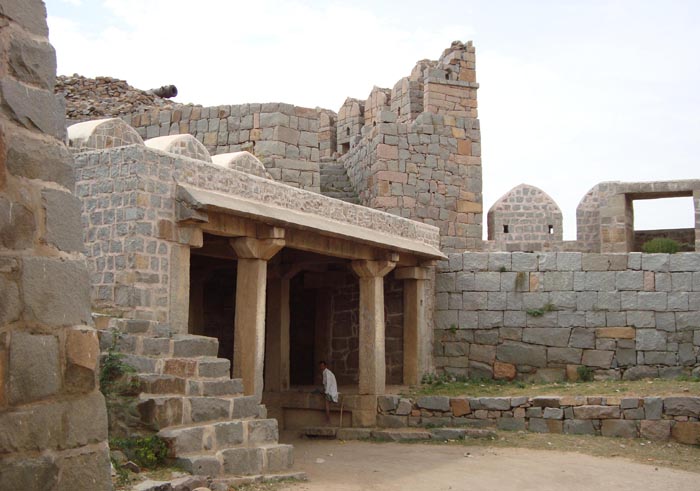Mudgal Fort

Information on Mudgal Fort (Raichur, Karnataka) - History & Architecture
The most interesting place of Mudgal is Mudgal Fort. It is situated in Raichur district of Karnataka and created on a hillock. However, the fortification of the fort were created on plain land. It is a massive fort which cover large area and is surrounded by mountains on one side. The mountain act as a natural obstacle to enter into the fort. However, at present, the fort has not been maintained properly.
Mudgal Fort Architecture
Mudgal Fort was tactically created at the top of hill where the rocky layers paved for the creation of royal houses. The external ramparts of Mudgal Fort encompass an area of about a half square mile. In the outer side of the fort, there is an extensive channel which is occupied with water. The breadth of the channel differs according to several places of the fort. Behind the channel, there is a brawl with a row of mainstays. From the structure, it is obvious that Mudgal Fort was reconstructed after the creation of guns. The sequences of stonework at various places of the fort are based on Hindu architectural style, where the arch shaped ramparts is based on Muslim architecture.
Apart from the main entrance, there is another entrance in Mudgal Fort which is situated in western portion. The wall of the fort is created by cyclopean architectural style. On every portion of the passage of the entrance, there exist rooms for the guards. There is also a third entrance which is in rounded shape. The third entrance is quite massive in comparison with other two entrances. The guard room which is linked with the passage of third entrance is also capacious than the other guard rooms. There is a mosque near the third entrance which comprise a dual pillared gallery. The pillars are designed in Hindu architectural style. The outer walls of Mudgal Fort possesses various statues of Hindu idols. The fort also houses an ancient Roman Catholic Church which was supposed to be created in 1557 AD.
Mudgal Fort History
The presence of Mudgal dates back to Neolithic age. It was recognised as a most significant place of historical concern. In 11th century, Mudgal was a key educational hub for students who arrive from various parts of the nation. The history of Mudgal Fort dates back to 14th century during the rule of Yadava family. The capital of Yadava dynasty was Devagiri. There are several captions that was discovered from Mudgal Fort which reveal the rule of Yadava dynasty around the area. On that time, Mudgal Fort was regarded as a garrison of Kakatiya kingdom. Later Malik Naib had seized Devagiri and captured Mudgal as well as the Raichur district. They established the Bahmani dynasty and took control over Mudgal Fort. In later days, the fort was controlled by the rulers of Bijapur. Bijapur kings took possession of the western and southern portions of the territory of Bahmani kingdom comprising Mudgal as well as Raichur area. However, in 16th century the ruler of Mudgal was again changed by Vijaynagar Empire. Vijaynagar kings successfully captured the Mudgal Fort from Bijapur rulers. According to historical explanations, considerable number of battles were fought between Vijaynagar rulers and Bahmani sultans in order to control Mudgal area as well as Mudgal Fort.
Mudgal Fort Tourism Importance
Created by Muslim and Hindu architectural style, Mudgal Fort is considered as a beautiful tourist destination. The fort also has historical significance where various rulers has fought in order to capture the fort as well as the region. The grand structure of the fort along with the surrounding beautiful hill where it exist makes Mudgal Fort a place worth visiting.
- Bangalore Monuments
- Bagalkot Monuments
- Belgaum Monuments
- Bellary Monuments
- Bidar Monuments
- Bijapur Monuments
- Chitradurga Monuments
- Coorg Monuments
- Dakshina Kannada Monuments
- Gadag Monuments
- Gulbarga Monuments
- Hassan Monuments
- Mysore Monuments
- Raichur Monuments
- Uttara Kannada Monuments
- Yadgir Monuments
- Andaman Nicobar Monuments
- Andhra Pradesh Monuments
- Assam Monuments
- Bihar Monuments
- Chhattisgarh Monuments
- New Delhi Monuments
- Goa Monuments
- Gujarat Monuments
- Haryana Monuments
- Himachal Pradesh Monuments
- Jammu and Kashmir Monuments
- Karnataka Monuments
- Kerala Monuments
- Madhya Pradesh Monuments
- Maharashtra Monuments
- Odisha Monuments
- Punjab Monuments
- Rajasthan Monuments
- Tamil Nadu Monuments
- Telangana Monuments
- Uttar Pradesh Monuments
- West Bengal Monuments